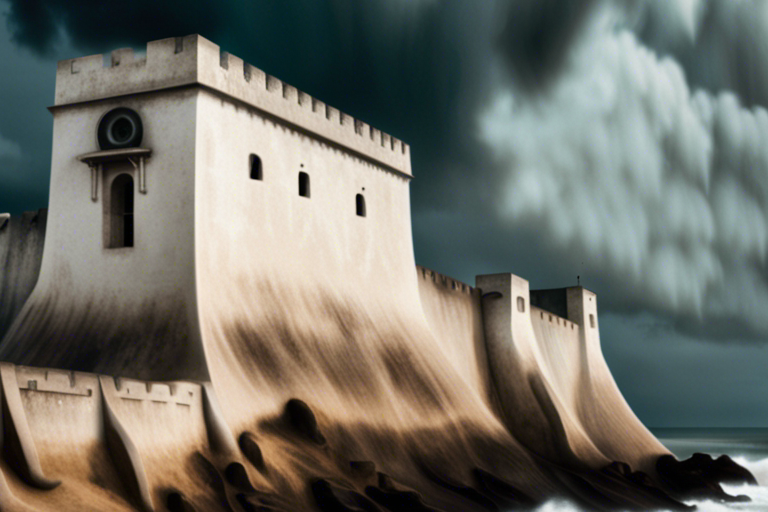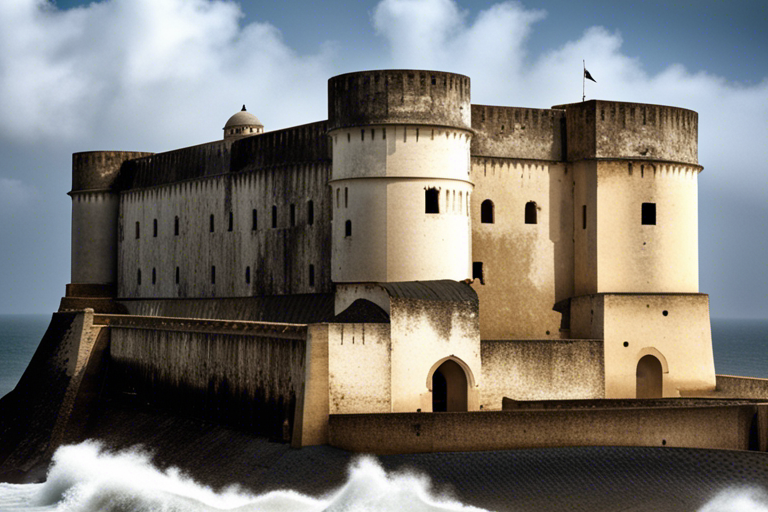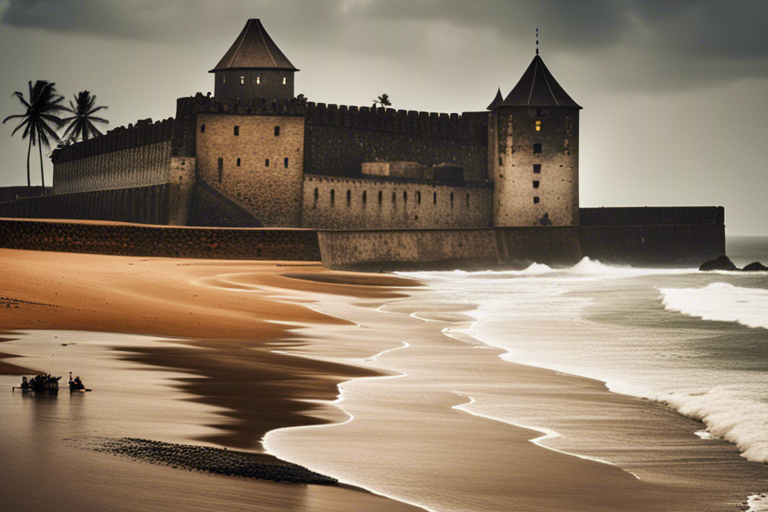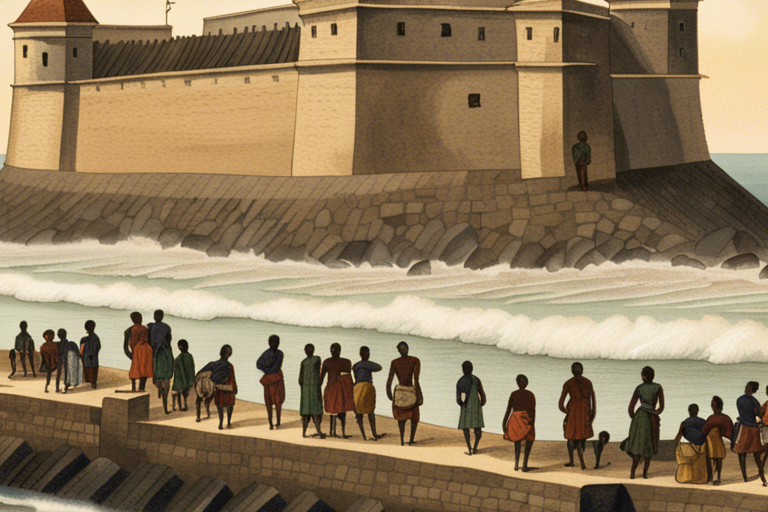
Ghana Slave Castle: 7 Shocking Facts You Didn’t Know About Ghana Slave Castles

Did you know that the picturesque coast of Ghana holds a dark history within its ancient walls? Deep in the heart of Ghana, you will find the remnants of slave castles, haunting reminders of a painful past. In this blog, we will take you on a journey through time as we explore seven shocking facts about Ghana’s slave castles.
Imagine standing in the same spot where countless lives were torn apart, where human beings were treated as property. It’s a chilling thought, but by uncovering these truths, we hope to shed light on a subject that is often overlooked.
Throughout the blog, we will delve into the depths of history to unearth stories of resilience, survival, and the unimaginable horrors endured by those trapped within these castle walls. Let’s explore the hidden narratives and untold tales of bravery that shaped Ghana’s past.
Short Summary
- The coast of Ghana holds the remnants of slave castles, reminding us of a painful past.
- Cape Coast Castle and Elmina Castle are notable examples of slave castles with a dark history.
- The “Door of No Return” symbolizes the harrowing experiences of captive Africans.
- The Ghana slave castles are not just historical sites but also UNESCO World Heritage Sites, ensuring their preservation.
The Historical Significance of Slave Castles

Ghana Slave castles hold a deep historical significance as powerful reminders of the immense human suffering endured during the transatlantic slave trade. These fortified structures, scattered along the West African coast, served as trading posts, detention centers, and departure points for millions of enslaved Africans who were forcibly transported across the Atlantic. In this section, we will explore the historical context and importance of slave castles, focusing on two prominent examples—the Cape Coast Castle and the Elmina Castle.
Quote: “Slave castles play a crucial role in preserving the memory of slavery and promoting understanding and empathy among visitors.” (Source: Smithsonian National Museum of African American History and Culture)
Quote: “Visiting slave castles can be a transformative experience, fostering empathy, understanding, and a commitment to fight against injustice and inequality.” (Source: United Nations Educational, Scientific and Cultural Organization)
Cape Coast Castle: A Dark Chapter in History

Cape Coast Castle stands as a haunting reminder of Ghana’s harrowing past. This imposing fortress, located on the country’s picturesque coast, holds within its walls stories of unimaginable suffering and resilience. Let’s explore some shocking facts about Cape Coast Castle and its role in the transatlantic slave trade.
A Hub of European Influence:
1. European Traders and the Gold Coast:
The Gold Coast, as Ghana was known during the colonial era, attracted European traders seeking to exploit its abundant resources.
Cape Coast Castle was built by the Portuguese in the late 15th century as a hub for their operations on the West African coast.
Over time, control of the castle shifted between various European powers, including the British, Dutch, and Swedish.
The Dark History:
2. Heartbreaking Slave Trade:
Cape Coast Castle became a significant hub for the transatlantic slave trade, often referred to as the “door of no return.”
Countless Africans captured from different regions were held captive within the castle’s dungeons, enduring unimaginable conditions.
These enslaved individuals were subsequently transported across the Atlantic, destined for a life of forced labor on plantations in the Americas.
Challenges Faced:
3. Struggles under British Colonial Rule:
After the abolition of the slave trade, Cape Coast Castle continued to be an emblem of British colonial power in the region.
The castle was used as a colonial administrative center, housing British governors and serving as a symbol of dominance.
The local population faced immense challenges to their culture and autonomy under British rule.
Preservation Efforts:
4. Recognizing the Significance:
In acknowledgment of its historical importance, Cape Coast Castle was designated as a UNESCO World Heritage site in 1979.
Efforts by various organizations, including the Ghanaian government and the Monuments Board, have been made to preserve and interpret the site accurately.
Projects like the Zamani Project have used laser scanning technology to digitally capture the castle’s structure and create a permanent record for future generations.
The Visit Experience:
5. A Journey to the Past:
Today, Cape Coast Castle offers visitors a poignant experience that sheds light on the atrocities of the transatlantic slave trade.
Guided tours take you through the castle’s dungeons, offering a glimpse into the cramped and damp conditions endured by enslaved individuals. Visitors can also explore the various chambers and chambers where African chiefs and European traders once conducted business.
As you walk through the halls of Cape Coast Castle, it’s impossible to ignore the weight of history that hangs in the air. The remnants of shackles and chains serve as a stark reminder of the inhumane treatment inflicted upon those held captive within these walls. It is a sobering experience, one that forces visitors to confront the painful legacy of slavery and the enduring impact it has had on generations of people.
But amidst the darkness of Cape Coast Castle’s past, there is also a glimmer of hope. The castle has become a platform for education and dialogue, a catalyst for change. Through educational exhibits and guided tours, visitors gain a deeper understanding of the transatlantic slave trade and its repercussions. They are encouraged to reflect upon the past and consider its implications for the present.
Cape Coast Castle has also become a site for healing and reconciliation. Descendants of both the enslaved and the enslavers have come together to share their stories, to seek understanding and empathy. The castle has become a place where conversations about racism, inequality, and social justice take place. It is a space for acknowledging the painful truths of history and working towards a more inclusive and equitable future.
Moreover, Cape Coast Castle serves as a testament to the resilience of the African people. Despite the unimaginable hardships faced within these walls, Africans have not only survived but thrived.
Elmina Castle: The First European Trading Post

Elmina Castle, located on the scenic coastline of Ghana, holds a significant place in history as the very first European trading post established in West Africa. Built by the Portuguese in the late 15th century, the castle played a pivotal role in shaping the transatlantic slave trade and the colonial power dynamics that unfolded in the region. Let’s delve into some shocking facts about Elmina Castle that will undoubtedly leave you astounded.
1. The Gateway to the Atlantic Slave Trade: Elmina Castle, also known as São Jorge da Mina, served as a major hub for the transatlantic slave trade. European traders, including the Portuguese, British, and Dutch, utilized Elmina Castle to facilitate the capture, imprisonment, and subsequent sale of captive Africans. The castle’s strategic location along the Gulf of Guinea allowed for easy access to slave ships waiting in the Atlantic Ocean.
2. The Door of No Return: Within Elmina Castle, there is a poignant site known as the “Door of No Return.” This infamous doorway symbolizes the irreversible journey that enslaved Africans were forced to embark upon. Stepping through this door meant a life of unimaginable hardships and suffering aboard the slave ships, often never to see their homeland again. Today, the Door of No Return stands as a solemn reminder of the atrocities of the transatlantic slave trade.
3. A Dark and Tragic History: Elmina Castle witnessed countless horrors during its time as a slave trading post. The dungeon chambers, located beneath the castle, were incredibly cramped, damp, and devoid of light. Enslaved Africans were crammed into these dehumanizing spaces, with limited access to food, water, and fresh air. The conditions within the castle were meant to break their spirits and erase their sense of identity and dignity.
4. The Role of European Nations: Over time, ownership of Elmina Castle shifted between various European nations, reflecting the changing tides of colonial power in West Africa. The Portuguese were the first to establish the castle, followed by the Dutch and later the British, who were the last European nation to control Elmina Castle before it gained independence. Each transition of power marked a continuation of the brutal slave trade within its walls.
5. A UNESCO World Heritage Site: In recognition of its historical significance, Elmina Castle was designated as a UNESCO World Heritage Site in 1979. This prestigious status aims to preserve and protect this harrowing reminder of humanity’s dark past and serves as a stark reminder of the need for remembrance, understanding, and education.
Visiting Elmina Castle today is an immersive experience that allows visitors to step back in time and witness the haunting remnants of the transatlantic slave trade. As you walk through the castle’s corridors and chambers, you can almost feel the weight of history bearing down on you. The dimly lit passageways, the cramped cells, and the chilling presence of the Door of No Return all serve as visceral reminders of the inhumanity and suffering that took place within these walls.
But amidst the somber atmosphere, there is also a sense of resilience and hope. Elmina Castle has been transformed into a space for dialogue and introspection. It serves as a powerful educational tool, with exhibits and guided tours providing a deep understanding of the transatlantic slave trade and its impact on African history and culture. Through these experiences, visitors are encouraged to reflect on the past and engage in discussions about the ongoing fight against racism and inequality.
Furthermore, Elmina Castle has become a site of healing and reconciliation. People from diverse backgrounds, including descendants of enslaved Africans and European traders, have come together to share their stories and seek understanding and empathy. It is a testament to the power of forgiveness and the importance of acknowledging painful truths in order to move forward.
The Door of No Return: Symbolizing a Painful Past

The Door of No Return, found in both Cape Coast Castle and Elmina Castle, serves as a haunting symbol of the pain and suffering endured during the transatlantic slave trade. Positioned at the edge of the castles, it represents the final departure point for enslaved Africans who were forcibly taken from their homelands and loaded onto ships bound for the Americas.
1. A Profoundly Emotional Experience:
Stepping through the Door of No Return is an emotional and thought-provoking experience. Visitors are immediately confronted with the harsh reality that millions of Africans passed through this very door, embarking on a journey marked by unimaginable cruelty and human suffering.
The gravity of the moment is further intensified as visitors stand on the rocky shores, gazing out at the vast expanse of the Atlantic Ocean, which served as a treacherous path for countless enslaved Africans.
2. A Reminder of the Transatlantic Slave Trade:
The Door of No Return acts as a somber reminder of the magnitude and impact of the transatlantic slave trade. It symbolizes the irreversible loss of freedom and the severance of ancestral ties for those who were forcibly taken from Africa.
As visitors pass through the door, they are encouraged to reflect upon the atrocities committed during this dark period in history and to honor the resilience and endurance of those who survived.
3. Historical Significance:
Both Cape Coast Castle and Elmina Castle served as major hubs of the transatlantic slave trade, operated by European traders who profited immensely from the buying and selling of African captives.
The Door of No Return specifically marks the departure point for slaves who were transported to destinations such as the United States, the Caribbean, and South America. It is a testament to the volume and scale of human suffering that occurred at these sites.
4. Preservation and Education:
Efforts have been made to preserve the castles and the Door of No Return as important historical sites. The Ghanaian government, in collaboration with non-profit research groups like the Zamani Project, has worked to document and digitally preserve these structures for future generations.
By educating visitors about the history of the transatlantic slave trade and the significance of the Door of No Return, these sites aim to foster greater understanding, empathy, and the promotion of human rights.
💡 key Takeaway: The Door of No Return, located in Cape Coast Castle and Elmina Castle, serves as a powerful symbol of the painful past endured by enslaved Africans during the transatlantic slave trade. As visitors step through this symbolic doorway, they are confronted with the weight of history and the unimaginable suffering that took place.
The experience of passing through the Door of No Return is profoundly emotional and thought-provoking. It is a stark reminder of the millions of Africans who were forcibly taken from their homelands, stripped of their freedom, and thrust into a life of bondage. Standing on the rocky shores, with the vast expanse of the Atlantic Ocean before them, visitors can imagine the treacherous journey that awaited these enslaved individuals.
This haunting symbol is a constant reminder of the transatlantic slave trade’s magnitude and impact. It represents the irreversible loss of freedom, the severance of ancestral ties, and the overwhelming trauma experienced by those who were captured and sold. Passing through the door encourages visitors to reflect upon the atrocities committed during this dark period in history and to honor the strength and resilience of those who survived.
Both Cape Coast Castle and Elmina Castle hold immense historical significance as major centers of the transatlantic slave trade. Operated by European traders who profited greatly from the buying and selling of African captives, these castles played a central role in the perpetuation of slavery.
5. São Jorge da Mina: Exploring the Portuguese Influence

São Jorge da Mina, commonly known as Elmina Castle, offers visitors a unique glimpse into the colonial power dynamics and exploitation that characterized the transatlantic slave trade. Originally established by the Portuguese in the 15th century, this fortress was strategically positioned to control and dominate the lucrative trade routes along the coast of West Africa.
The castle’s impressive architecture and imposing presence reflect the Portuguese quest for wealth and control, as well as their ruthless pursuit of economic gains through the enslavement and exploitation of Africans. Walking through its halls and chambers, visitors can’t help but feel the weight of history and the oppressive atmosphere that once permeated these walls.
7. A Window into Daily Lives of Enslaved Africans:
Beyond its role as a trading post, Elmina Castle also serves as a poignant reminder of the daily lives and experiences of enslaved Africans. The castle complex housed not only European traders but also thousands of captive Africans who were subjected to unimaginable hardships and suffering.
Exploring the cramped dungeons and dank prison cells, visitors can witness firsthand the dehumanizing conditions in which enslaved individuals were held before being forcefully shipped across the Atlantic. The remnants of shackles and restraints are stark reminders of the physical and psychological torment endured by those trapped within these walls.
8. The Legacy of Resistance:
Amidst the atrocities and oppression, Elmina Castle also stands as a testament to the indomitable spirit of resistance among enslaved Africans. Despite the unimaginable hardships they faced, many captives found ways to assert their agency, resist their captors, and forge connections with fellow prisoners.
Stories of acts of resistance have been preserved and passed down through generations, allowing visitors to learn about the resilience and strength of those who were held captive within Elmina Castle’s walls. These stories serve as a reminder that even in the darkest of times, humanity can find ways to resist and fight for freedom.
Visitors to Elmina Castle can explore the various areas where resistance took place, such as secret meeting spots, hidden messages, and cleverly disguised forms of communication. These remnants offer a glimpse into the ingenuity and determination of enslaved Africans who refused to be completely silenced by their captors.
By immersing oneself in the history of resistance within Elmina Castle, visitors gain a deeper understanding of the complex dynamics of power and oppression during the transatlantic slave trade. It serves as a stark reminder that while the physical bondage may have been pervasive, the spirit of freedom and resistance remained alive within the hearts of those who were subjected to such unimaginable suffering.
9. Reckoning with the Past:
Acknowledging and reckoning with the painful legacy of the transatlantic slave trade is crucial for healing and understanding.
💡 key Takeaway: São Jorge da Mina, also known as Elmina Castle, stands as a stark reminder of the Portuguese influence during the transatlantic slave trade. This historical site witnessed unimaginable suffering and continues to serve as a monument of resilience and a call for remembrance and education.
Exploring the Ghana Slave Castles: An Unforgettable Experience

The Ghana slave castles stand as somber reminders of the dark and painful history of the Transatlantic Slave Trade. These castles, including Cape Coast Castle and Elmina Castle, were once trading posts for European traders in West Africa. Here are some shocking facts that will leave you astonished at the lasting impact of this tragic chapter in history.
1. The Door of No Return: Stepping into History
The Door of No Return, found in both Cape Coast Castle and Elmina Castle, is an iconic symbol of the slave trade. Slaves were forced through this door, leaving their homeland forever, bound for a life of unimaginable suffering across the Atlantic.
“Stepping through the Door of No Return was a chilling experience. I could almost feel the pain and despair of the enslaved Africans who passed through here,” shared one visitor.
2. A Hub of the Slave Trade: British Colonial Rule
During the height of British colonial rule, Cape Coast Castle served as the seat of government and a major center for the slave trade.
Elmina Castle, originally built by the Portuguese as São Jorge da Mina, changed hands multiple times and became one of the most significant slave trading posts on the West African coast.
3. Preservation and UNESCO Recognition
The Ghanaian government, in collaboration with the Monuments and Museums Board, has taken great strides in preserving and restoring these historical sites.
Both Cape Coast Castle and Elmina Castle have been recognized as UNESCO World Heritage Sites, ensuring their cultural and historical significance is protected for future generations.
4. Beyond the Castles: The Zamani Project
The Zamani Project, a non-profit research group, has employed cutting-edge technology like laser scanning to create accurate digital models of the slave castles. These models serve as a permanent record and a means to engage with the sites’ history in a new and interactive way.
5. Captive Africans: The Horrors of the Dungeons
Descending into the dungeons of the slave castles is an emotionally challenging experience. These damp and stifling spaces held captive Africans before they were shipped across the Atlantic.
“The dungeons were a stark reminder of the inhumanity that took place within these walls. It was a deeply haunting experience that left me speechless,” shared another visitor.
6. Consequences of the Transatlantic Slave Trade
The consequences of the transatlantic slave trade were far-reaching and continue to impact societies today. The forced migration and enslavement of millions of Africans resulted in the loss of countless lives, cultures, and communities. It tore families apart, eroded social structures, and perpetuated racial inequality and discrimination.
The economic impact of the slave trade cannot be underestimated. European nations and their colonies amassed enormous wealth through the exploitation of African labor. The trade in human beings fueled industries such as sugar plantations, cotton farms, and mining operations. The profits generated from these enterprises laid the foundation for the development of modern capitalist economies.
In addition to the economic repercussions, the transatlantic slave trade had profound cultural and psychological effects. The brutality and dehumanization endured by enslaved Africans left deep scars that are still felt today. Generations of Africans and African descendants have had to grapple with the legacy of slavery and the enduring trauma it inflicted.
Furthermore, the transatlantic slave trade fueled the rise of racism and racial ideologies that justified the subjugation of Africans. These ideas continue to shape attitudes and power dynamics, leading to ongoing racial disparities and systemic injustices.
It is crucial to remember the transatlantic slave trade as a stark reminder of humanity’s capacity for cruelty and a testament to the resilience and strength of those who survived. By acknowledging this dark chapter in history, we can work towards dismantling the lingering effects of slavery and promoting equality and justice for all.
Slave Castles as UNESCO World Heritage Sites
The slave castles of Ghana serve as a haunting reminder of the dark history of the transatlantic slave trade. These architectural remnants hold not only historical significance but have also been recognized as UNESCO World Heritage Sites. Here are seven shocking facts about these slave castles and their inclusion in this prestigious list:
1. Cape Coast Castle: A Symbol of Resilience
Built by European traders, Cape Coast Castle served as a major hub for the Atlantic slave trade in West Africa.
This castle witnessed the capture and imprisonment of countless African men, women, and children who were destined for a life of enslavement.
Recognized by UNESCO in 1979, Cape Coast Castle symbolizes the resilience and strength of the survivors who managed to resist and endure the horrors of slavery.
2. Elmina Castle: The Oldest European Structure in Sub-Saharan Africa
Elmina Castle, originally called São Jorge da Mina, was established by the Portuguese in 1482.
It remains the oldest European structure in sub-Saharan Africa and stands as a testament to the long-lasting impact of colonial powers in the region.
Elmina Castle was inscribed as a UNESCO World Heritage Site in 1979 due to its historical significance and the need to preserve its cultural heritage.
3. Door of No Return: A Heartbreaking Departure
The Door of No Return, found in both Cape Coast Castle and Elmina Castle, represents the last experience captive Africans had on their homeland before being forcibly transported across the Atlantic.
This symbolic doorway serves as a poignant reminder of the inhumanity of the transatlantic slave trade and the irreversible separation of families and communities.
4. Slave Castles and the Atlantic Slave Trade
These slave castles played a significant role in the Atlantic slave trade, acting as trading posts, storage facilities, and incarceration centers.
European nations and companies, such as the British, Swedish Africa Company, and others, utilized these castles to exploit the rich resources of the Gold Coast and capture Africans for enslavement.
5. Preservation Efforts: The Zamani Project
The Zamani Project, a non-profit research group, has undertaken the monumental task of using cutting-edge technology to digitally document these historic slave castles.
Through laser scanning and 3D modeling, the Zamani Project aims to create a permanent record of these sites for future generations to study and learn from. This preservation effort not only ensures that the physical structures of the slave castles are protected, but it also allows for a deeper understanding of the experiences of those who suffered within their walls.
6. Lessons from the Slave Castles
Visiting the slave castles in Ghana offers a profound educational experience, shedding light on the horrors of the transatlantic slave trade and its lasting impact. By walking through the dungeons and witnessing the cramped and dehumanizing conditions that enslaved Africans endured, visitors are confronted with the harsh realities of this dark chapter in history.
These visits serve as a reminder of the importance of never forgetting the atrocities committed during the transatlantic slave trade. It is through education, reflection, and acknowledgement that we can strive to prevent such injustices from happening again.
7. Legacy and Resilience
Despite the unimaginable suffering and trauma inflicted upon them, the descendants of those who were enslaved display remarkable resilience and strength. Their contributions to art, music, literature, and various fields of knowledge are a testament to their ability to preserve their cultural heritage and thrive despite the odds.
By recognizing the legacy of the transatlantic slave trade, we honor the resilience and courage of those who endured it. We can learn from their experiences and work towards a more inclusive and just society, where racial equality and human rights are upheld for all.
Conclusion
In conclusion, exploring the shocking facts surrounding Ghana’s slave castles is a harrowing yet essential journey to understanding the dark history of the transatlantic slave trade. These fortresses, once regarded as symbols of power and wealth, now serve as somber reminders of the human suffering endured within their walls. By visiting these castles and learning about the stories of enslaved Africans, we can deepen our empathy and advocate for justice. It is crucial to educate ourselves and others about the untold stories that lie hidden in the chambers of these castles. Additionally, supporting local organizations and initiatives that work towards preserving and telling the stories of the slave castles is an actionable step we can take. Whether it’s through visiting the castles ourselves, spreading awareness online
FAQ
Can you visit the slave castles in Ghana?
Yes, the slave castles in Ghana are open to visitors. Many tour companies and local guides offer tours of these historic sites, which can provide a powerful and educational experience. However, it is important to be respectful and mindful of the sensitive nature of these locations.
How many slave castles are in Ghana?
There are a total of 6 remaining slave castles in Ghana, with the most well-known being Cape Coast Castle and Elmina Castle. These castles were used to hold captive Africans before they were forced onto ships and sent into slavery.
Where are the main slave castles located in Ghana?
Some of the main slave castles in Ghana are located in the coastal towns of Cape Coast and Elmina. These include the Cape Coast Castle and the Elmina Castle, both of which were major hubs for the transatlantic slave trade. Other slave castles can also be found in the towns of Fort Amsterdam, Fort St. Jago, and Fort Metal Cross.
How were slave castles used?
Slave castles in Ghana were used as holding areas for enslaved Africans before they were shipped off to the Americas. These castles were often cramped, unsanitary, and lacking in basic necessities, making them a brutal and dehumanizing experience for the enslaved individuals held there. Many of these castles still stand today as a reminder of the atrocities of the transatlantic slave trade.
What is the significance of the Door of No Return?
The Door of No Return is a symbol of the horrific history of the transatlantic slave trade in Ghana. It was the last point of exit for enslaved Africans before they were shipped off to the Americas. The door serves as a reminder of the inhumane treatment and suffering endured by millions of Africans during this dark period in history. It is also a powerful symbol of resilience and strength, as many descendants of enslaved Africans have returned to Ghana to reclaim their roots and honor their ancestors.
